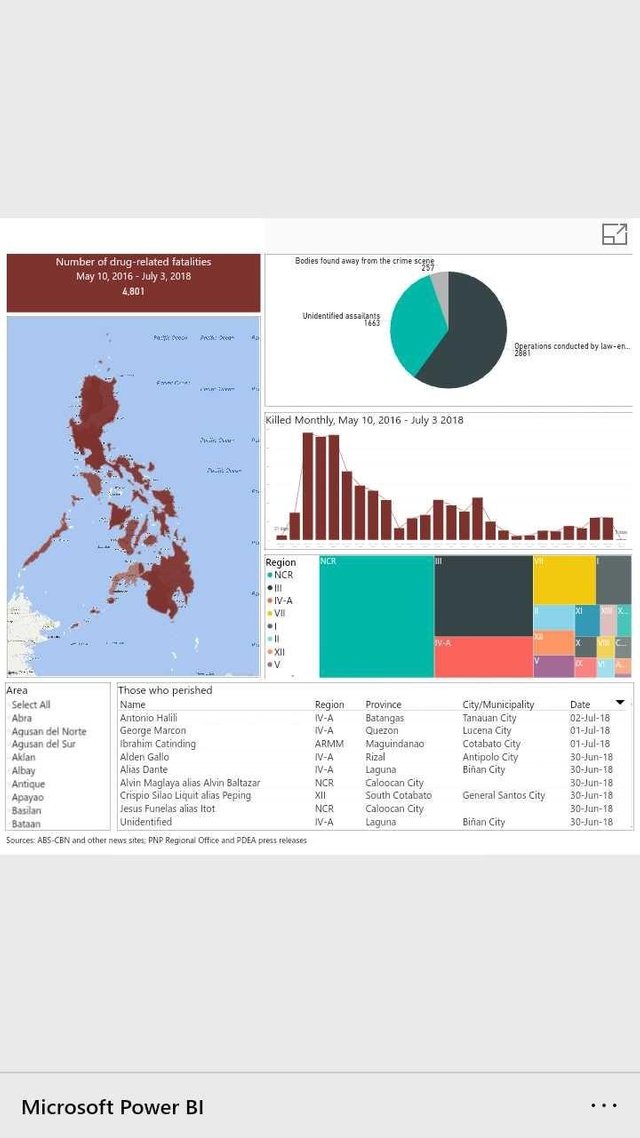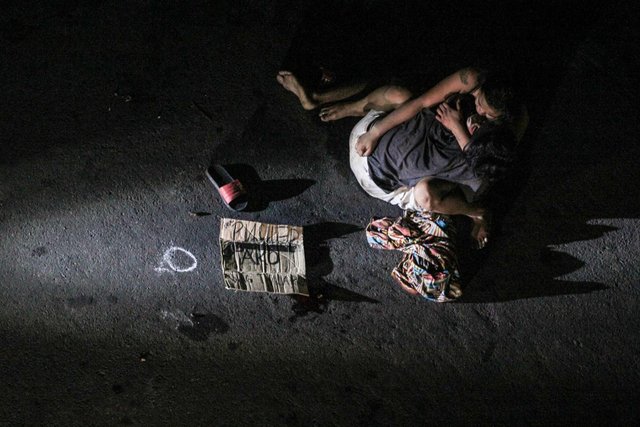The Death Toll of the War on Drugs
Death Toll of the War on Drugs
These interactive map and charts show the drug-related fatalities reported since May 10, 2016 based on ABS-CBN's independent monitoring of national and local news reports, and PNP Regional Office and PDEA press releases.
ABS-CBN categorized these fatalities tagged in drugs by the way they were killed:
a) Killed in operations conducted by law-enforcement agencies: the alleged drug suspects were killed by police and other law enforcement officers during the conduct of anti-illegal drug operations, including entrapment operations, raids, and follow-up operations. This category also includes those killed in in flagrante delicto cases (in the very act of committing a crime) and apprehensions that reportedly escalated to a shootout.
b) Killed by unidentified assailants: the individuals tagged in drugs were killed by unidentified assailants in shooting incidents or by motorcycle-riding gunmen. The incident was either witnessed by other people or captured on CCTV.
c) Bodies found away from the crime scene: the victims' bodies were discovered with a label tagging them in drug-related activities (usually a cardboard bearing the words "drug pusher", "drug user" or "drug addict") or there are illegal drugs reportedly recovered from the body. The victims' faces and bodies usually bear gunshot wounds, and sometimes even stab wounds. The victims' arms or legs, or both, are also usually bound and the bodies wrapped in tape.
The proportion of each category relative to the total death toll is illustrated in the pie chart. The heat map illustrates the magnitude of drug-related deaths per province/city: the redder the color of a province/city in the map, the higher the number of drug-related deaths reported in that area.
The table meanwhile, shows the names and aliases of those who were killed, as well as the dates and areas where the killings took place. Each column in the table is sortable.
The data on the map, charts, and table are interconnected. For example, clicking on a province/city on the map will show the corresponding details for that area in the charts and tables, such as the death toll in that province/city; the names of those killed and the dates when the incidents took place; and the type of incident. Clicking on the chart and tables will likewise reveal the corresponding information on the map.
The data may also be viewed per province/city by ticking on the list. It is possible to tick more than one province/city on the list.
Clicking on the white space anywhere on the chart will restore the map, charts, and tables to default view.

EXPLORE ABS-CBN
googletag.cmd.push(function() { googletag.display('div-WarOnDrugs-SuperLeaderboard'); });
googletag.impl.pubads.createDomIframe("div-WarOnDrugs-SuperLeaderboard_ad_container" ,"/2744311/ABSNews_WarOnDrugs_SuperLeaderboard_0",false,false);
The Death Toll of the War on Drugs
MAP, CHARTS: The Death Toll of the War on Drugs
ABS-CBN Investigative and Research Group
Posted at July 13, 2016 5:30 PM | Updated as of July 04, 2018 03:36 PM
Facebook
Twitter
GPlus
LinkedIn
Pinterest
These interactive map and charts show the drug-related fatalities reported since May 10, 2016 based on ABS-CBN's independent monitoring of national and local news reports, and PNP Regional Office and PDEA press releases.
ABS-CBN categorized these fatalities tagged in drugs by the way they were killed:
a) Killed in operations conducted by law-enforcement agencies: the alleged drug suspects were killed by police and other law enforcement officers during the conduct of anti-illegal drug operations, including entrapment operations, raids, and follow-up operations. This category also includes those killed in in flagrante delicto cases (in the very act of committing a crime) and apprehensions that reportedly escalated to a shootout.
b) Killed by unidentified assailants: the individuals tagged in drugs were killed by unidentified assailants in shooting incidents or by motorcycle-riding gunmen. The incident was either witnessed by other people or captured on CCTV.
c) Bodies found away from the crime scene: the victims' bodies were discovered with a label tagging them in drug-related activities (usually a cardboard bearing the words "drug pusher", "drug user" or "drug addict") or there are illegal drugs reportedly recovered from the body. The victims' faces and bodies usually bear gunshot wounds, and sometimes even stab wounds. The victims' arms or legs, or both, are also usually bound and the bodies wrapped in tape.
The proportion of each category relative to the total death toll is illustrated in the pie chart. The heat map illustrates the magnitude of drug-related deaths per province/city: the redder the color of a province/city in the map, the higher the number of drug-related deaths reported in that area.
The table meanwhile, shows the names and aliases of those who were killed, as well as the dates and areas where the killings took place. Each column in the table is sortable.
The data on the map, charts, and table are interconnected. For example, clicking on a province/city on the map will show the corresponding details for that area in the charts and tables, such as the death toll in that province/city; the names of those killed and the dates when the incidents took place; and the type of incident. Clicking on the chart and tables will likewise reveal the corresponding information on the map.
The data may also be viewed per province/city by ticking on the list. It is possible to tick more than one province/city on the list.
Clicking on the white space anywhere on the chart will restore the map, charts, and tables to default view.
Sources: News sites of ABS-CBN, GMA 7, Philippine Daily Inquirer, Philippine Star, Manila Bulletin, DZIQ Radyo Inquirer 990 AM, DZRH News, Sunstar Bacolod, Sunstar Baguio, Sunstar Cagayan de Oro, Sunstar Davao, Sunstar Cebu, Sunstar Pampanga, Sunstar Zamboanga, Cebu Daily News, The Manila Times, The Standard, Tempo, Bombo Radyo Philippines, The Freeman, MindaNews, Mindanao Times, Mindanao Goldstar Daily, The Bohol Chronicle, Bicol Today, and press releases from PNP Regional Office and Philippine Drug Enforcement Agency websites.
Updates:
On Oct. 11, 2017, the first category was revised from “killed in police operations” to “killed in operations conducted by law-enforcement agencies” to reflect the transfer of leadership in the implementation of the war on drugs from the Philippine National Police to the Philippine Drug Enforcement Agency by virtue of a memorandum signed by President Duterte on Oct. 10, 2017.
The new category also encompasses the death toll when PDEA took charge of anti-illegal drug operations from Jan. 31 to March 5, 2017 upon President Duterte’s pronouncement on Jan. 29, 2017 to dissolve all PNP anti-drug groups following allegations of involvement by a number of police officers in the kidnap-slay of Korean businessman Jee Ick-Joo. On Jan. 30, a day after the president's pronouncement, PNP Chief Ronald dela Rosa “dissolved” all police anti-drug units and suspended the war on drugs.
Thanks for read my article :)

Hi! I am a robot. I just upvoted you! I found similar content that readers might be interested in:
http://news.abs-cbn.com/specials/map-charts-the-death-toll-of-the-war-on-drugs